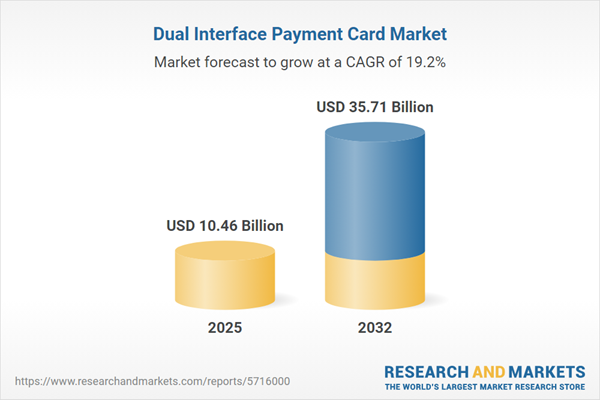Speak directly to the analyst to clarify any post sales queries you may have.
Senior decision-makers navigating the rapidly evolving payment sector are at a critical crossroads: adopting dual interface payment cards with advanced digital and security capabilities is now central to staying ahead in today’s strategic landscape.
Market Snapshot: Dual Interface Payment Card Market Growth and Momentum
The global dual interface payment card market is expanding rapidly, propelled by increasing investment in digital payment infrastructure. Heightened emphasis on regulatory compliance and fraud mitigation is accelerating the transition from legacy contactless models to sophisticated, integrated platforms. This shift is impacting banking, retail, and transit sectors as organizations modernize payment solutions and prioritize secure, seamless user experiences. Tightening regulatory standards are steering focus toward robust authentication and streamlined processes, improving both operational efficiency and risk management. As enterprise adoption accelerates, market leaders are pursuing technological innovation and more user-centric, integrated payment solutions, fostering greater ecosystem connectivity.
Scope & Segmentation: Strategic Dimensions Guiding Enterprise Adoption
- Form Factors: Embedded modules, plastic cards, stickers, and wearables cater to varied compliance mandates and user needs, with protocols designed to safeguard authentication and security.
- Distribution Channels: Partnerships among original equipment manufacturers, chip suppliers, card producers, platform vendors, system integrators, and retailers—both digital and traditional—expand market reach and scale.
- Applications: Solutions are implemented across banking, public transit, government benefits, access management, and loyalty programs, each emphasizing compliance, security, and operational streamlining for distinct user objectives.
- End Users: Banks, government agencies, retailers, financial services firms, transit authorities, and airlines leverage dual interface payments to advance transaction security and streamline administrative processes, optimizing workflows in diverse environments.
- Technologies: EEPROM, ferroelectric RAM, embedded secure elements, UICC modules, and microcontrollers ranging from 8 to 32 bits provide flexible deployment options, encourage compliance, and stimulate ongoing ecosystem innovation.
- Regions: Adoption strategies vary across the Americas, Europe, Middle East, Africa, and Asia-Pacific due to different regulatory landscapes and market demands. Local mandates and the need for seamless integration are decisive in shaping deployment tactics and driving collaboration among stakeholders.
Key Takeaways for Strategic Leadership
- Dual interface payment cards create unified bridges between digital and physical payment methods, enhancing operational coherence and improving the customer experience across every payment channel.
- Integration of advanced microcontroller technologies and next-generation security architectures positions organizations to anticipate and meet evolving compliance requirements while reducing exposure to security incidents.
- Flexible configuration options help firms adapt to changing cyber risks, regulatory shifts, and diverse user preferences, minimizing operational disruption and costly process overhauls.
- Stronger alliances among semiconductor vendors, system integrators, and card issuers ensure that deployed technologies remain compatible and responsive to new regulatory and market shifts.
- Rapid adaptation to consumer and compliance trends is enabled by alternative form factors, such as stickers and wearables, which help organizations stay responsive within fast-moving markets.
- Continuous innovations in payment card technology enable seamless connections across a growing array of devices and platforms, supporting forward-looking enterprise digital transaction initiatives.
Tariff Impact: Navigating U.S. Policy Shifts
Recent U.S. tariff policy adjustments have increased costs for key card materials and semiconductor inputs. Organizations are countering these changes by diversifying supplier portfolios and cultivating regional manufacturing partnerships, especially near essential end markets. Regional sourcing—particularly in Asia-Pacific—improves supply chain flexibility, supports faster adaptation to new trade and regulatory requirements, and limits operational disruption. These strategies ensure enterprise continuity and reliable card deployment despite evolving policy landscapes.
Methodology & Data Sources
This report draws from leading industry publications, regulatory resources, executive interviews, validated surveys, and contributions from expert panels. By blending secondary research and expert perspectives, the methodology delivers robust, unbiased coverage of dual interface payment card adoption and technology trends.
Why This Report Matters for Strategic Leadership
- Supports proactive decision-making as market dynamics shift, equipping leaders to identify and capitalize on emerging opportunities in the dual interface payment card domain.
- Enables coordinated action across innovation, compliance, and procurement, building organizational agility and reinforcing a competitive edge amid evolving requirements.
- Prepares executives to manage supply chain uncertainty, evolving workforce needs, and changing regulatory conditions, supported by actionable, research-driven insights.
Conclusion: Executing Informed, Resilient Strategies
This analysis delivers essential insights for executives leading digital payment initiatives, supporting organizational adaptability and long-term resilience in an evolving payment landscape.
Additional Product Information:
- Purchase of this report includes 1 year online access with quarterly updates.
- This report can be updated on request. Please contact our Customer Experience team using the Ask a Question widget on our website.
Table of Contents
3. Executive Summary
4. Market Overview
7. Cumulative Impact of Artificial Intelligence 2025
Companies Mentioned
The companies profiled in this Dual Interface Payment Card market report include:- IDEMIA Group SAS
- Thales SA
- Eastcompeace Technology Co., Ltd.
- Watchdata Technologies Co., Ltd.
- CPI Card Group Inc.
- Valid Soluções e Serviços de Segurança em Meios de Pagamento S.A.
- Mühlbauer Group GmbH & Co. KG
- Entrust Corporation
- Toppan Printing Co., Ltd.
Table Information
| Report Attribute | Details |
|---|---|
| No. of Pages | 189 |
| Published | October 2025 |
| Forecast Period | 2025 - 2032 |
| Estimated Market Value ( USD | $ 10.46 Billion |
| Forecasted Market Value ( USD | $ 35.71 Billion |
| Compound Annual Growth Rate | 19.1% |
| Regions Covered | Global |
| No. of Companies Mentioned | 10 |









